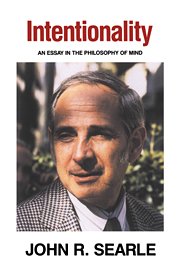Book contents
- Frontmatter
- Contents
- Acknowledgements
- Introduction
- 1 The nature of Intentional states
- 2 The Intentionality of perception
- 3 Intention and action
- 4 Intentional causation
- 5 The Background
- 6 Meaning
- 7 Intensional reports of Intentional states and speech acts
- 8 Are meanings in the head?
- 9 Proper names and Intentionality
- 10 Epilogue: Intentionality and the brain
- Subject index
- Name index
3 - Intention and action
Published online by Cambridge University Press: 05 June 2012
- Frontmatter
- Contents
- Acknowledgements
- Introduction
- 1 The nature of Intentional states
- 2 The Intentionality of perception
- 3 Intention and action
- 4 Intentional causation
- 5 The Background
- 6 Meaning
- 7 Intensional reports of Intentional states and speech acts
- 8 Are meanings in the head?
- 9 Proper names and Intentionality
- 10 Epilogue: Intentionality and the brain
- Subject index
- Name index
Summary
In the course of our discussion of the Intentionality of mental states such as belief and desire and mental events such as visual experiences, we have developed a fairly extensive conceptual apparatus for analyzing problems of Intentionality, an apparatus that includes the notions of Intentional content, psychological mode, conditions of satisfaction, direction of fit, causal self-referentiality, direction of causation, Network, Background, and the distinction between presentations and other sorts of representations. The explanation of Intentionality in terms of these notions is not intended to be reductive, since each is an Intentional notion. We are not trying to show that Intentionality is really something else, but rather to explain it in terms of a family of notions each of which is explained independently, usually by way of examples. To repeat: there is no nonintentional standpoint from which we can survey the relations between Intentional states and their conditions of satisfaction. Any analysis must take place from within the circle of Intentional concepts.
The aim of this chapter is to explore the relations between intentions and actions, using this apparatus. At first sight intentions and actions seem to fit very neatly into the system. We are inclined to say: Just as my belief is satisfied iff the state of affairs represented by the content of the belief actually obtains, and my desire is satisfied iff the state of affairs represented by the content of the desire comes to pass, so my intention is satisfied iff the action represented by the content of the intention is actually performed.
Information
- Type
- Chapter
- Information
- IntentionalityAn Essay in the Philosophy of Mind, pp. 79 - 111Publisher: Cambridge University PressPrint publication year: 1983
